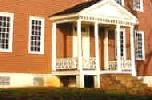 |
The Alexander Chapel Built in the
1880s,and razed in 1997. Named after Archibald Alexander,a prominent Presbyterian minister
and theologian in the first half of the 19th century
Contributed by Paula Lucy Delosh |
 |
Barboursville Ruins Built 1814 -
1822 by James Barbour, partly after plans
made by Thomas Jefferson. It was burned on Christmas Day 1884. Barbour was
Governor of Virginia, United States Senator, Secretary of War and Minister to
England.
Photographed Jan 1997 and Contributed by George Seitz |
 |
Beaumont Circa 1857, it was built
by William Jennings for Dr. James L. Jones. The doctor operated the Beaumont Female School
on the same tract
Photographed 21 May 2010 and Contributed by George Seitz. |
 |
Blue Ridge Turnpike Tollhouse
Circa 1850. At the eastern end of the Blue Ridge Turnpike. The tollkeeper's house has been
modernized and remodeled into a private dwelling.
Photographed 21 May 2010 and Contributed by George Seitz. |
 |
Chestnut Hill Built in 1859 by
original owner Alexander Daley, a tanner by trade, he outlived two wives and kept the
house for several years after the death of his second wife in 1881. He sold to Reuben
Conway Macon and his wife. Macon was a great-nephew of President James Madison. Macon a
farmer also serving as the town's postmaster for several years in the 1880s. Today
Chestnut is a bed & breakfast. Its on the Virginia Landmarks Register and National
Register of Historic Places.
Photographed and Contributed by Paula Lucy Delosh |
 |
Christ Episcopal Church Built in
1875, it was made possible by Bolling Walker Haxall, a prominent Richmond businessman. It
is a Gothic Revival sanctuary that features painted windows imported from England
Photographed 11 May 2010 and Contributed by George Seitz. |
 |
Depot the old depot in
the town of Orange.
Contributed by Sandy Onbey |
 |
Eheart House Circa 1860. B.F.
Eheart lived there. He ran a general store that contained the post-office at the
crossroads of the Old Ridge Road and the Rockingham Turnpike.
Photographed 22 Jun 2010 and Contributed by George Seitz. |
 |
Ellwood Building date: 1780 or
1782, Builder: William Jones. 15 miles west of Fredericksburg on Rt. 20. Primary owners:
William Jones, Lacy family, Hugh Willis, Leo Jones. Jones employed Hessian prisoners of
war to build the house. In 1824 Lafayette visited here and the house served as a Union
headquarters during the Civil War. It was also a hospital. The most interesting
association is that Stonewall Jackson's amputated arm is buried here.
Photographed Apr 2008 and Contributed by Paula Lucy Delosh |
 |
Exchange Hotel Circa 1860, it was
a military hospital during the Civil War. The Greek Revival hotel is three stories tall
and retains much of the original woodwork. It now contains exhibits on Civil War Medicine
and local history.
Photographed 11 May 2010 and Contributed by George Seitz. |
 |
First E. J. Faulconer House The
oldest surviving residence on Main Street in Gordonsville. It was built in 1856 by
Benjamin Faulconer, the owner's brother. It has imaginative details in the decorative
woodwork.
Photographed 11 May 2010 and Contributed by George Seitz. |
 |
Second E.J. Faulconer House Begun
just before the Civil War, it was completed in 1868. Like his first house, Edward
Faulconer's brother Benjamin built this. It is undergoing a complete restoration
Photographed 11 May 2010 and Contributed by George Seitz. |
 |
Frascati Completed in 1823 for
Phillip Pendleton Barbour. He was a judge who served in the Virginia Assembly. Eventually
he was Speaker of the United States House of Representatives and then a Justice of the
United States Supreme Court.
Photographed 21 May 2010 and Contributed by George Seitz. |
 |
Gilmore Cabin George Gilmore,
born a slave on the Montpelier Plantation about 1810, was freed with the Federal
occupation of Orange County in 1865. He established this small farmstead near the
plantation where he had been enslaved. Today it illustrates the history of the
African-American transition from slavery to freedom
Photographed 21 May 2010 and Contributed by George Seitz. |
 |
Harvey House Circa 1855. At the
crossroads of Eheart, it was built as a story and a half and raised to its current height.
A fairly typical frame over stone village dwelling of its era.
Photographed 22 Jun 2010 and Contributed by George Seitz. |
 |
Hazelhurst Circa 1856. It was
built as a two-story brick dwelling over a raised English basement. The roof was raised
and other remodeling has given it its Georgian Revival appearance.
Photographed 22 Jun 2010 and Contributed by George Seitz. |
 |
Jordan Circa 1830. A frame house
with brick end chimneys. Built on a hall-and-parlor plan, it has had several additions.
Photographed 11 May 2010 and Contributed by George Seitz. |
 |
Martin House This log house faced
with plank is said to have been built in 1853 by
William Henry Martin (1819-1890) who was Justice of Peace in
Unionville. In 1963 the house was owned by Lee Waugh, was torn down and a
new house was built in the rear of the property.
Contributed by Paula Lucy Delosh
|
 |
CW Monument This is
the monument to the Confederate Dead that stands next to the courthouse in downtown Orange.
Contributed by Sandy Onbey |
 |
St. Thomas' Episcopal Church 119
Caroline Street. Oldest church in Orange, Founded in 1740. On November 22,1863 General
Robert E.Lee and Jefferson Davis attended services here.
Contributed by Paula Lucy Delosh |
 |
St. Thomas' Episcopal Church One
of its stained glass windows.
Contributed by Paula Lucy Delosh |
 |
Somerset Christian Church Circa
1859. Built as a simple rectangular structure, it was given unique details such as an
overhanging roof, curved exposed rafter ends and Tuscan porch columns.
Photographed 22 Jun 2010 and Contributed by George Seitz. |
![]() Orange County
Photo Album Index
Orange County
Photo Album Index